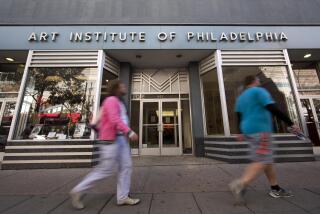For-profit colleges slammed in Democratic Senate staff report
- Share via
WASHINGTON — For-profit colleges are failing their students and saddling taxpayers with an enormous bill, a two-year investigation by the Senate education panel’s Democratic staff concluded.
The harsh report, released Monday by the committee’s chairman, Sen. Tom Harkin (D-Iowa), found that federal taxpayers spent $32 billion on for-profit colleges in 2009-10, while more than half of the students who enrolled in them dropped out without degrees after about four months in 2008-09.
“In this report, you will find overwhelming documentation of exorbitant tuition, aggressive recruiting practices, abysmal student outcomes, taxpayer dollars spent on marketing and pocketed as profit, and regulatory evasion and manipulation,” Harkin said. “These practices are not the exception — they are the norm.”
But Steve Gunderson, president of the Assn. of Private Sector Colleges and Universities and a former Republican congressman, said the report “twists the facts to fit a narrative, proving that this is nothing more than continued political attacks on private sector colleges and universities.”
Republicans on the Senate Health, Education, Labor and Pensions Committee, which is controlled by Democrats, also criticized the report, saying it used biased information and failed to include Republican input, raising “substantial doubt about the accuracy of the information.”
The report linked the high dropout rates with a lack of money spent on instruction at for-profit colleges, finding that in 2010 the 30 for-profit colleges that were examined employed 35,202 recruiters compared with 3,512 career services staffers. The companies examined in the report spent 42.1% of their revenue on marketing, recruiting and profits, while spending 17.2% on instruction.
More than 80% of the revenue at for-profit colleges came from federal financial aid, Harkin said.
“It’s plain common sense that taxpayer dollars should not be used for lobbying,” he added.
Gunderson said for-profit colleges deal with a constituency — mainly working adults, parents and veterans — that can be reached only through marketing and recruiting. To ban the use of revenue for lobbying would “result in the end of private sector colleges and universities,” he said.
But many recruiters mislead prospective students about the cost of the program, the availability of federal aid, the job placement rate and the transferability of credits, the report said.
The Education Department estimates that 96% of students at for-profit colleges take out loans, a much higher percentage than students at community colleges, four-year public universities and nonprofit private colleges. Students at for-profit colleges account for 13% of the nation’s college enrollment but 47% of all federal student loan defaults.
The report concluded that significant reforms were needed to ensure that for-profit colleges succeeded financially only when students also succeeded and that taxpayer dollars were used for educational purposes.
In early July, attempts by the Education Department to penalize for-profit colleges whose graduates ended up with huge debts and low job prospects were struck down by a federal judge.
For-profit colleges can still lose federal student aid if more than 90% of their revenue comes from federal sources or their students have high loan default rates in the three years after graduation.
Democratic members of the committee called for legislation to better regulate for-profit colleges, including adding new rules to the Higher Education Act, which is scheduled to be reauthorized next year.
“If nothing else this report has put the nation on notice that there is a problem here,” said Sen. Richard Blumenthal (D-Conn.).
More to Read
Sign up for Essential California
The most important California stories and recommendations in your inbox every morning.
You may occasionally receive promotional content from the Los Angeles Times.













